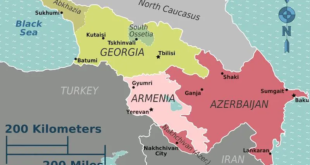 The bear is back. That’s what all too many Russia-watchers have been saying since Russian troops steamrolled Georgia in August, warning that the country’s strongman, Vladimir Putin, was clawing his way back toward superpower status.
The bear is back. That’s what all too many Russia-watchers have been saying since Russian troops steamrolled Georgia in August, warning that the country’s strongman, Vladimir Putin, was clawing his way back toward superpower status.
Â
The new Russia’s resurgence has been fueled — quite literally — by windfall profits from gas and oil, a big jump in defense spending and the cocky attitude on such display during the mauling of Georgia, its U.S.-backed neighbor to the south. Many now believe that the powerful Russian bear of the Cold War years is coming out of hibernation.
Â
Not so fast, writes Professor Murray Feshbach in his extensive article in the “Washington Post”, and then points out:
Â
Predictions that Russia will again become powerful, rich and influential ignore some simply devastating problems at home that block any march to power. Sure, Russia’s army could take tiny Georgia. But Putin’s military is still in tatters, armed with rusting weaponry and staffed with indifferent recruits. Meanwhile, a declining population is robbing the military of a new generation of soldiers. Russia’s economy is almost totally dependent on the price of oil.
Â
And, worst of all, it’s facing a public health crisis that verges on the catastrophic.
Â
To be sure, the skylines of Russia’s cities are chock-a-block with cranes. Industrial lofts are now the rage in Moscow, Russian tourists crowd far-flung locales from Thailand to the Caribbean, and Russian moguls are snapping up real estate and art in London almost as quickly as their oil-rich counterparts from the Persian Gulf. But behind the shiny surface, Russian society may actually be weaker than it was even during Soviet times. The Kremlin’s recent military adventures and tough talk are the bluster of the frail, not the swagger of the strong.
Â
While Russia has capitalized impressively on its oil industry, the volatility of the world oil market means that Putin cannot count on a long-term pipeline of cash flowing from high oil prices. A predicted drop of about one-third in the price of a barrel of oil will surely constrain Putin’s ability to carry out his ambitious agendas, both foreign and domestic.
Â
That makes Moscow’s announced plan to boost defense spending by close to 26 percent in 2009 — in order to fully re-arm its military with state-of-the-art weaponry — a dicey proposition. What the world saw in Georgia was a badly outdated arsenal, one that would take many years to replace — even assuming the country could afford the $ 200 billion cost.
Â
Something even larger is blocking Russia’s march. Recent decades, most notably since the breakup of the Soviet Union in 1991, have seen an appalling deterioration in the health of the Russian population, anchoring Russia not in the forefront of developed countries but among the most backward of nations.
Â
This is a tragedy of huge proportions — but not a particularly surprising one, at least to me. I followed population, health and environmental issues in the Soviet Union for decades, and more recently, I have reported on diseases such as the HIV/AIDS epidemic ravaging the Russian population. I’ve visited Russia more than 50 times over the years, so I can say from firsthand experience that this national calamity isn’t happening suddenly. It’s happening inexorably.
Â
According to U.N. figures, the average life expectancy for a Russian man is 59 years — putting the country at about 166th place in the world longevity sweepstakes, one notch above Gambia. For women, the picture is somewhat rosier: They can expect to live, on average, 73 years, barely beating out the Moldovans. But there are still some 126 countries where they could expect to live longer. And the gap between expected longevity for men and for women — 14 years — is the largest in the developed world.
Â
So what’s killing the Russians? All the usual suspects — HIV/AIDS, tuberculosis, alcoholism, cancer, cardiovascular and circulatory diseases, suicides, smoking, traffic accidents — but they occur in alarmingly large numbers, and Moscow has neither the resources nor the will to stem the tide. Consider this:
Â
- Three times as many Russians die from heart-related illnesses as do Americans or Europeans, per each 100,000 people.
Â
- Tuberculosis deaths in Russia are about triple the World Health Organization’s definition of an epidemic, which is based on a new-case rate of 50 cases per 100,000 people.
Â
- Average alcohol consumption per capita is double the rate the WHO considers dangerous to one’s health.
Â
- About 1 million people in Russia have been diagnosed with HIV or AIDS, according to WHO estimates. Using mid-year figures, it’s estimated that 25 percent more new HIV/AIDS cases will be recorded this year than were logged in 2007.
Â
And none of this is likely to get better any time soon. Peter Piot, the head of UNAIDS, the U.N. agency created in response to the epidemic, told a press conference this summer that he is “very pessimistic about what is going on in Russia and Eastern Europe . . . where there is the least progress.”
Â
This should be all the more worrisome because young people are most at risk in Russia. In the United States and Western Europe, 70 percent of those with HIV/AIDS are men over age 30; in Russia, 80 percent of this group are aged 15 to 29. And although injected-drug users represent about 65 percent of Russia’s cases, the country has officially rejected methadone as a treatment, even though it would likely reduce the potential for HIV infections that lead to AIDS.
Â
And then there’s tuberculosis — remember tuberculosis? In the United States, with a population of 303 million, 650 people died of the disease in 2007. In Russia, which has a total of 142 million people, an astonishing 24,000 of them died of tuberculosis in 2007. Can it possibly be coincidental that, according to Gennady Onishchenko, the country’s chief public health physician, only 9 percent of Russian TB hospitals meet current hygienic standards, 21 percent lack either hot or cold running water, 11 percent lack a sewer system, and 20 percent have a shortage of TB drugs? Hardly.
Â
On the other end of the lifeline, the news isn’t much better. Russia’s birth rate has been declining for more than a decade, and even a recent increase in births will be limited by the fact that the number of women age 20 to 29 (those responsible for two-thirds of all babies) will drop markedly in the next four or five years to mirror the 50 percent drop in the birth rate in the late 1980s and the 1990s. And, sadly, the health of Russia’s newborns is quite poor, with about 70 percent of them experiencing complications at birth.
Â
Last summer, Piot of UNAIDS said that bringing Russia’s HIV/AIDS epidemic under control was “a matter of political leadership and of changing the policy.” He might just as well have been talking about the much larger public health crisis that threatens this vast country.
Â
But the policies seem unlikely to change as the bear lumbers along, driven by disastrously misplaced priorities and the blindingly unrealistic expectations of a resentment-driven political leadership. Moscow remains bent on ignoring the devastating truth: The nation is not just sick but dying.
Murray Feshbach is a senior scholar at the Woodrow Wilson International Center for Scholars and a research professor emeritus at Georgetown University’s School of Foreign Service.
Department of Cooperation and Mass-Media,
Kavkaz Center
 Eurasia Press & News
Eurasia Press & News



